| Development
in Nepal: Reports on Tourism |
 |
Nepal Development |
|
 |
Nepal Information |
|
|
 |
|
Food
insecurity and market access in contested districts |
 |
KATHMANDU,
2 Feb 2006 (IRIN)
 |
| Food
shortages during the pre-harvest seasons of March and August have been
part of life in rural Nepal for decades. Since the start of the Maoist
insurgency in 1996, analysts have been concerned about the impact of the
conflict on a rural population that already lives near or below the global
poverty threshold. |
|
Until
recently, much of the available information in Nepal on the impact of conflict
on food security, agricultural production, nutritional status and market
access has been largely anecdotal. A recent exception to this is vulnerability
monitoring by the World Food Programme (WFP), which started in the far
and mid-western districts of Nepal in October 2002.
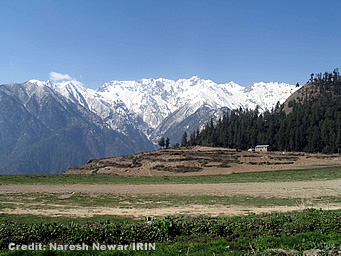 |
| Most mountain districts, like Humla,are regarded as food deficit areas.
Humla has one of the worst food deficits in the country and the Human Development
Index of the area is believed to be one of the lowest in the world.
WFP
data offers a broad insight into the scale of the problem. Earlier this
year, this UN agency reported that 39 of Nepal's 75 districts were food-deficient,
with serious constraints to food access in many mountain districts. An
estimated 60 percent of rural households could not produce enough food
to meet their basic requirements and were in need of supplementary help. |
|
Identifying
what food defecits result from conflict, as opposed to chronic underdevelopment,
has been difficult.
In
September 2005, an non-government organisation's (NGO's) field assessment
found that the nutritional and health status of people varied markedly
depending on the area visited. It also confirmed that the conflict had
been a catalyst for the deterioration in the living conditions of most
of the population.
An
earlier study, conducted by David Seddon and Jagannath Adhikari in 2003,
challenged some preconceptions. The exodus of young people from rural Nepal
has long been held as a cause of agricultural decline. It has also been
suggested that food security was made much worse due to livestock depletion
by the Maoists or security forces.
In
fact, Seddon and Adhikari maintain that farming has been kept up by elders
who have largely remained on the farms, while the depletion of animals
has affected specific communities, but has not been a general phenomenon.
Instead,
the study found that by far the most significant impact of the conflict
on food security, has been the reduction in physical movement, which has
"reduced the volume and value of goods transported and services provided".
top
| Market
access in Rukum District |
 |
Lack
of access was confirmed by local farmers in Nepal's Rukum district. While
they had little trouble working the fields, their greatest obstacle was
the inability to move freely around the district. This had deprived them
of vital supplies, seeds, the ability to graze livestock unhindered, and
most importantly, access to the local market.
 |
Speaking
anonymously, farmers in a village 4 km from the district headquarters,
Musikot, claimed local Maoists restricted the movement of people or goods
in
the area and especially into the army-controlled hill town.
"We
are a farming community. We produce foods and take them to the district
market. But we have been completely denied that access," he said. |
|
This
had put the farmers in a conundrum. "Going to market under cover of night
and hoodwinking local leaders is extremely risky," he said. Farmers here
were also at a competitive disadvantage, as other villages without a permanent
Maoist presence were more able to smuggle food into Musikot much more easily
and safely.
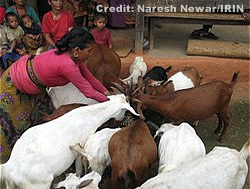 |
| Frequent
political strikes and government curfews mean that goods from villages
often will not reach markets in district centers. Many villagers, such
as this goat trader in Rukum, have to take difficult and dangerous routes
around the district.
The
entire local market had changed due to the conflict, said the farmer. They
were now being instructed by local Maoists to take their produce to other
parts of the district that were not under army control. |
|
A
nearby village, Sakhe, used to be the main potato supplier for the area.
"Now they don't grow as many potatoes and don't bring them here [Musikot].
Instead they have to take potatoes to markets that are much further away,"
he said.
A
local agricultural supplier based in Musikot, Prem Jung Malla, said business
had been very bad over the last five years. "There's been very little movement
to the district town, and the other side [Maoists] stop people from leaving
the villages. People are scared of both sides of the conflict, so movement
has dropped," he said.
The
restrictions on movement have directly affected crop production, as farmers
were not able to secure agricultural inputs at the right times of the year.
Malla said the Maoist blockades could last for several days at a time,
and disrupt supplies so much that farmers would not have sufficient fertiliser
or inputs to maximise their yield.
"Sometimes
they just miss their sowing seasons for certain crops," said Malla.
| Maoist
fees and taxes |
 |
According
to the farmers, the local Maoists now had control of the most profitable
local businesses, including forestry and the herbal trade. The area was
rich in one particular herb called yasha gumba, which was sought after
in India for its medicinal properties.
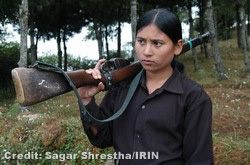 |
| To
make matters worse, the farmers were being pressured to sign up with the
local Maoist business committee, for which there would be a joining fee.
"So again they are raising money from us. But if we do decide to sign up
with them, then the army is going to suspect us of having become Maoists,"
a farmer explained.
Equally
unpopular was the rebels' tax regime. In the past, only traders dealing
in herbs and crops would be responsible for paying taxes. |
|
Since
the Maoists had arrived, ordinary farmers were also expected to pay. Maoist
taxes ranged from 1 percent for food, up to 10 percent for luxury items.
Alcohol was prohibited and televisions were subject to a 50 percent charge.
Local
traders said there was no option but to pass these taxes on to farmers,
which in turn meant they could spend less on agricultural inputs.
| Temporary
Reprieve |
 |
The
unilateral ceasefire introduced in September 2005 has made a significant
difference to movement in the Rukum district, as the local Maoists are
rarely seen. Although people are still extremely wary, goods are now arriving
on time and farmers are venturing out from the villages to buy essential
seeds and supplies.
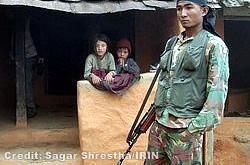 |
| A
farmer from Rathamartha, Sashi Ram Oli, who had travelled to the district
town to buy seed potatos, stated that he would never have made the journey
had it not been for the lull in the fighting. Prior to the ceasefire, he
would rarely leave his house, except at night to check irrigation canals
and livestock, he said.
His
frustration was palpable: "They need to settle this conflict at the centre. |
|
I would follow whoever is in government. But my life as a village farmer
is hard enough. I don't need all this."
| Food
crisis or not? |
 |
WFP
currently monitors over half of the 75 districts in Nepal and will be extending
its monitoring to 19 new districts in 2006. WFP Representative in Kathmandu,
Erika Joergensen, maintained that the results reflected chronic food insecurity
in the hills and mountains, but did not point to an imminent food crisis.
However, she did acknowledge the situation could deteriorate.
"We
could easily see increased vulnerability in those areas where we've seen
movements of people. We could certainly see increased needs if people started
to move," she said.
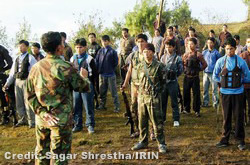 |
| To
date, WFP's approach has been to supplement local food intake, with food-for-work
and education projects. "We firmly think that the best approach is to reinforce
the structures already in place," she said.
This
approach was well-received by local communities. The food-for-education
programme had led to a rise in attendance at schools, particularly among
girls, while the food-for-work schemes have led to road building in some
districts. |
|
The
food security projects, which support 450,000 people per day, were considered
to be "80 percent effective", with a portion of projects suspended for
"a number of reasons" - a reference to the difficulties of working in contested
areas, where food aid may be blocked by one side or the other.
Joergensen
said not a day went by when she did not question whether they had "got
it right with the current approach". But she did not think that the current
situation warranted a shift to a relief mode, which could undermine WFP's
aid in support of local structures.
Due
to increased insecurity since 2003, WFP and NGO partners had introduced
Quick Impact Programmes to 10 badly affected districts. In addition, a
new software and satellite communications technology was being introduced
to enable WFP in Kathmandu to track the national food security situation
more accurately - on a weekly basis, instead of every month.
Joergensen
was also taking the precaution of ordering in special communications and
logistics equipment in the event WFP was called upon to react quickly to
a crisis.
| Pockets
of Vulnerability |
 |
A
field assessment by one international NGO, Action Contre la Faim (ACF,)
in September 2005, highlighted very different nutritional and health conditions,
depending on the district visited.
Yusuf
Hammache, Asia Desk officer for ACF in Paris, said the report was an opportunity
to dispel polarised views that Nepal is either a development challenge
or facing an apocalyptic crisis.
For
example, conditions in Kathmandu or on the Terai (the southern plain along
the border with India) and some parts of the far west, were best suited
to a development approach as economic exchanges and amenities continued
to function relatively well, he said.
However,
substantial regional variations mean Nepalis do not experience the year
in the same way. Other districts had witnessed seasonal food gaps, forced
or voluntary migration and increased vulnerability.
"It
has become clear to us that there are pockets of vulnerability in the country
and the conflict has been very much the catalyst for the degradation,"
he said.
Mark
Segal, conflict adviser in Kathmandu for the UK's Department for International
Development, maintained there could be sudden deterioration at a local
level. "Some local communities are very vulnerable, very poor and could
be pushed over from a tolerable, manageable situation into a real crisis,"
he said.
Credit
IRIN 2006
Copyright
Ⓒ UN Office for the Coordination of Humanitarian Affairs 2006
[
This report does not necessarily reflect the views of the United Nations] |
 |
Integrated
Regional Information Networks (IRIN), part of the UN Office for the Coordination
of Humanitarian Affairs (OCHA).
| Links |
 |
 |
 |
External
link |
 |
IRIN
News
|
 |
IRIN
News |
|









